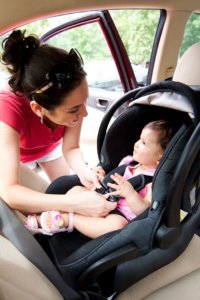Car Seat Safety: Your Guide to Safe Driving
By: Michael L. White, Esq & Cynthia Dort*
Updated October 2022

Without question, our children and infants are the most precious cargo when we drive our automobiles. As parents and guardians, we take every precaution necessary to ensure their safety, yet thousands of children are injured or killed in car accidents every year. This is primarily because almost half of all car seats are used incorrectly. [1] An improperly installed car seat can lead to devastating consequences which can impact your family forever. It is important to not only know the law but also to understand the best safety practices for your children.
Things to keep in mind: Your vehicle’s safety belts ARE NOT considered a child restraint system. A federally approved child restraint is a car seat that has an internal harness system. State law mandates the use of the appropriate car safety seat for your child passengers. Failure to follow these laws can result in fines or other consequences.
The law in New York State requires the following:
- Update Effective October 2022: Children from birth to 2 years of age must be in a rear-facing safety seat. There are 2 different rear-facing seats that will allow a parent/guardian to easily comply with this law:
- Infant Seat: This seat is used for newborns and children up to 35 lbs. in many cases. It has a base that remains in the seat, with a carry handle that allows easy removal from the base as well as placing the seat into the base.
- Convertible: This seat can be used rear-facing for children 5 – 40 lbs. in most cases, and then forward-facing for children up to 65 lbs. This seat is installed and does not have a base, so you must take the child in and out of the car seat each time.
- All children under the age of 4 must ride in a child safety seat.
- All children must ride in child restraint systems until their 8th birthday. An appropriate restraint system for children between the ages of 4 and 8 may include an approved booster seat.
- All child safety seats and restraint systems must be federally approved and appropriate to the age and weight of your child.
- Make sure your seat is installed properly by following the manufacturer’s instructions. For additional, free help, New York State has ongoing car seat check events available statewide. For a constantly updated list of these events, visit https://trafficsafety.ny.gov/.
- New York State law requires all motor vehicle passengers ages 8 and older to wear seat belts, regardless of seating position.
In addition to obeying the law, the following tips can help you achieve the best practices for car seat safety:
- Infant safety seats, (i.e., rear-facing child seats) should always be located in the back seat of your vehicle, as front passenger airbags can cause injury or death to children in safety seats in the event of a collision.
- Children should remain in each car seat or booster seat until they outgrow the weight and/or height of each seat.
- While the law says a child at ages 4 through 7 can be in a booster seat, the best practice is to keep a child in a 5-point harness so long as the child can comfortably fit.
- If you are using a booster seat, always use both the lap and shoulder belts in your vehicle to secure your child, never just the lap belt.
- Children should remain in a booster seat until they are 4’9” or 100 lbs. This is your average 11-year-old, not an 8-year-old. You can use a booster seat until an adult seat belt correctly fits the child without using the booster seat.
- Do not put small children in the front seat of a vehicle that has an airbag. Put a child that does not use a safety seat and who is less than 5 feet in height in the back seat.
- Register your car seat(s) to be informed of any important safety updates or recalls.
If you, or someone you know, has been injured in an automobile accident, please contact the experienced attorneys of Martin Harding & Mazzotti, LLP to discuss your rights. Don’t wait, click the “Live Chat Now” button to the left or call Martin, Harding & Mazzotti, LLP at 1800LAW1010 (1.800.529.1010).
* Cynthia Dort is the Extension Community Educator for Cornell University’s Cooperative Extension-Saratoga County. Cynthia is certified nationally and at the state level for the following: nationally Certified CPS Instructor, Alive @ 25 and Distracted Driving Instructor, and Occupant Protection Instructor. Additionally, Cynthia has spoken on the topic of safety, including car seat safety, at various locations throughout the Capital Region and has held and organized many programs designed to educate high school students.